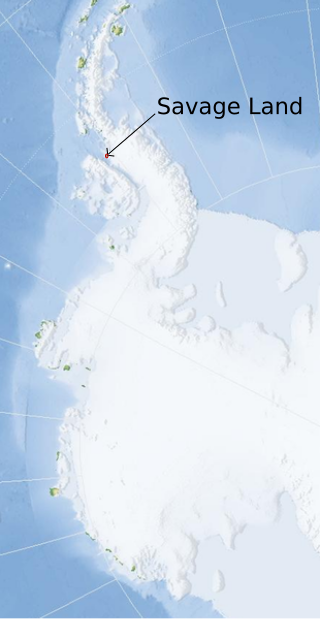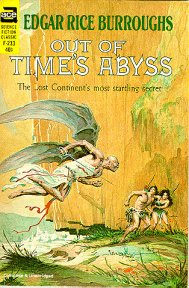
Pellucidar is a fictional Hollow Earth invented by American writer Edgar Rice Burroughs for a series of action adventure stories. In a crossover event, Tarzan, who was also created by Burroughs, visits Pellucidar.

The Savage Land is a fictional prehistoric land that features in American comic books published by Marvel Comics. It is a tropical preserve, hidden in Antarctica. It has appeared in many story arcs in Uncanny X-Men as well as other related books.

Cro-Magnon is an Aurignacian site, located in a rock shelter at Les Eyzies, a hamlet in the commune of Les Eyzies-de-Tayac-Sireuil, Dordogne, southwestern France.

"The Ugly Little Boy" is a science fiction short story by American writer Isaac Asimov. The story first appeared in the September 1958 issue of Galaxy Science Fiction under the title "Lastborn", and was reprinted under its current title in the 1959 collection Nine Tomorrows. The story deals with a Homo neanderthalensis child which is brought to the future by means of time travel. Robert Silverberg later expanded it into a novel with the same title published in 1992.

The caveman is a stock character representative of primitive humans in the Paleolithic. The popularization of the type dates to the early 20th century, when Neanderthals were influentially described as "simian" or "ape-like" by Marcellin Boule and Arthur Keith.
Dino-Riders is an animated television series that first aired in 1988. The cartoon was primarily a promotional show to launch a new Tyco toy line. Only fourteen episodes were produced, three of which were produced on VHS for the United States. The show aired in the U.S. as part of the Marvel Action Universe programming block.
Earth's Children is a series of epic historical fiction novels written by Jean M. Auel set circa 30,000 years before the present day. There are six novels in the series. Although Auel had previously mentioned in interviews that there would be a seventh novel, publicity announcements for the sixth confirmed it would be the final book in the sequence.

Cro is an American animated television series produced by the Children's Television Workshop and Film Roman. It was partially funded by the National Science Foundation. Every episode has an educational theme, introducing basic concepts of physics, mechanical engineering, and technology. The show's narrator is an orange woolly mammoth named Phil, who was found frozen in ice by a scientist named Dr. C and her assistant, Mike. After they defrost him, Phil tells both of them about life in the Ice Age, including stories about his friend Cro, a Cro-Magnon boy.

The Land That Time Forgot is a 1974 adventure fantasy film directed by Kevin Connor and written by Michael Moorcock and James Cawthorn, based upon the 1918 novel The Land That Time Forgot by Edgar Rice Burroughs. The film, which is a British-American co-production, stars Doug McClure, John McEnery, Keith Barron, Susan Penhaligon, Anthony Ainley and Declan Mulholland.
The lost world is a subgenre of the fantasy or science fiction genres that involves the discovery of an unknown Earth civilization. It began as a subgenre of the late-Victorian adventure romance and remains popular into the 21st century.

The People That Time Forgot is a 1977 adventure fantasy film based on the novel The People That Time Forgot (1963) and Out of Time's Abyss (1963) by Edgar Rice Burroughs. Filmed in Technicolor, it was produced by Britain's Amicus Productions and directed by Kevin Connor. Like Connor's other two Burroughs-derived films, The Land That Time Forgot and At the Earth's Core, the film was distributed in the United States by American International Pictures. It is the last film made by Amicus before the production company folded.

The Land That Time Forgot is a fantasy novel by American writer Edgar Rice Burroughs, the first of his Caspak trilogy. His working title for the story was "The Lost U-Boat". The sequence was first published in Blue Book Magazine as a three-part serial in the issues for August, October, and December 1918. The complete trilogy was later combined for publication in book form under the title of the first part by A. C. McClurg in June 1924. Beginning with the Ace Books editions of the 1960s, the three segments have usually been issued as separate short novels.

The People That Time Forgot is a fantasy novel by American writer Edgar Rice Burroughs, the second of his Caspak trilogy. The sequence was first published in Blue Book Magazine as a three-part serial in the issues for August, October, and December 1918, with The People That Time Forgot forming the second installment. The complete trilogy was later combined for publication in book form under the title of The Land That Time Forgot by A. C. McClurg in June 1924. Beginning with the Ace Books editions of the 1960s, the three segments have usually been issued as separate short novels.

Dance of the Tiger is a novel by Finnish palaeontologist Björn Kurtén, published in 1978 and English translation in 1980. It is a prehistoric novel dealing with the interaction between Neanderthals and Cro-Magnons. A sequel, Singletusk, published in 1982, continues the story of the family.

The Inheritors is a work of prehistoric fiction and the second novel by the British author William Golding, best known for his first novel, Lord of the Flies (1954). It concerns the extinction of one of the last remaining tribes of Neanderthals at the hands of the more sophisticated Homo sapiens. It was published by Faber and Faber in 1955.

Return To Eden is a 1988 science fiction novel by American writer Harry Harrison.

Out of Time's Abyss is a science fantasy novel by American writer Edgar Rice Burroughs, the third of his Caspak trilogy. The sequence was first published in Blue Book Magazine as a three-part serial in the issues for August, October, and December 1918, with Out of Time's Abyss forming the third installment. The complete trilogy was later combined for publication in book form under the title of The Land That Time Forgot by A. C. McClurg in June 1924. Beginning with the Ace Books editions of the 1960s, the three segments have usually been issued as separate short novels.

Mists of Dawn is a juvenile science fiction novel by science fiction writer and anthropologist Chad Oliver first published in 1952 by John C. Winston, Co. as a part of the Winston Science Fiction series of juvenile novels. The story follows the adventures of adolescent Mark Nye when he is accidentally transported to the Stone Age by his uncle's time machine. It includes a factual foreword on the science of anthropology and how Oliver uses this science in the telling of his story.

Cro-Magnons or European early modern humans (EEMH) were the first early modern humans to settle in Europe, migrating from western Asia, continuously occupying the continent possibly from as early as 56,800 years ago. They interacted and interbred with the indigenous Neanderthals of Europe and Western Asia, who went extinct 40,000 to 35,000 years ago. The first wave of modern humans in Europe left no genetic legacy to modern Europeans; however, from 37,000 years ago a second wave succeeded in forming a single founder population, from which all subsequent Cro-Magnons descended and which contributes ancestry to present-day Europeans. Cro-Magnons produced Upper Palaeolithic cultures, the first major one being the Aurignacian, which was succeeded by the Gravettian by 30,000 years ago. The Gravettian split into the Epi-Gravettian in the east and Solutrean in the west, due to major climatic degradation during the Last Glacial Maximum (LGM), peaking 21,000 years ago. As Europe warmed, the Solutrean evolved into the Magdalenian by 20,000 years ago, and these peoples recolonised Europe. The Magdalenian and Epi-Gravettian gave way to Mesolithic cultures as big game animals were dying out and the Last Glacial Period drew to a close.
The Testament of Man (1943–1960), a twelve-volume series of novels by the American author Vardis Fisher, traces the physical, psychological and spiritual evolution of Western civilization from Australopithecus to the present. The series explores a pantheon of subjects: myth, ritual, language, family, sex and especially sin, guilt and religion. Each work emphasizes a particular pathway that Fisher considered of paramount importance in the development of the modern world and our current views.
Enlightened minds must wonder what the world would be like today if the torrent [that carries us along] had taken another channel at any one of a dozen moments in history. What if Greek values had triumphed in that war more than twenty−one centuries ago?
















